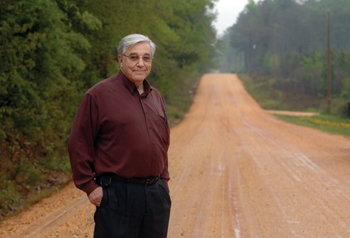
Billy Hudson, Ph.D., stands on the gravel-covered red clay of Garden Seed Road in rural Grapevine, Ark., where he grew up. (photo by Dana Johnson)
VUMC Reporter Profile — Billy Hudson’s ambitious math, science education plan honors his rural roots
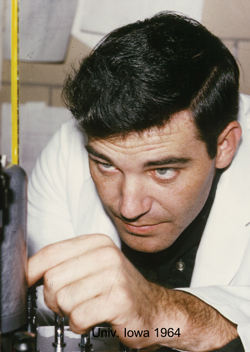
Billy Hudson, Ph.D., concentrates on his research at the University of Iowa in 1964.
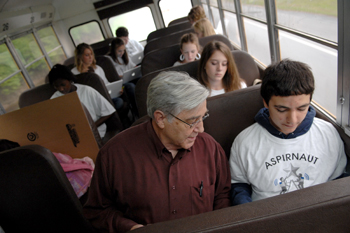
Hudson shares an online science lesson on the bus with eighth-grader Chris Cox, who wants to be a pediatrician when he grows up. (photo by Dana Johnson)
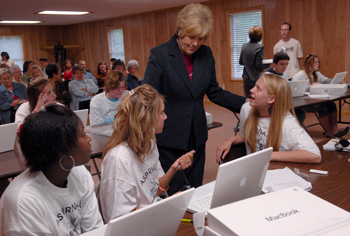
Hudson’s sister, Ann Kincl, chats with “Aspirnauts” in Grapevine’s Sardis Missionary Baptist Church, where they will gather for Webcasts from the Vanderbilt Center for Science Outreach. (photo by Dana Johnson)
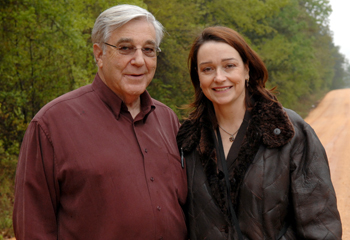
Billy and his wife, Julie Hudson, M.D., on Garden Seed Road. (photo by Dana Johnson)
Billy Hudson, Ph.D., is an internationally known scientist who helped discover the molecular underpinnings of autoimmune and hereditary kidney diseases.
He's an entrepreneur who co-founded two biotech companies to bring a potential treatment for diabetic kidney disease he developed to market.
Now, at age 65, Hudson, the Elliot V. Newman Professor of Medicine and Biochemistry at Vanderbilt University Medical Center, has returned to his roots — rural Grapevine, Ark. — with a bold plan to enrich math and science education for students at risk of being left out of the latest technological advances, educational opportunities and jobs.
Last week, Hudson passed out 15 laptop computers, donated by VUMC, for middle and high school students to use during their 60- to 90-minute bus rides to and from school every day. Equipped with broadband Internet access via cell-phone towers, their bus has been transformed into a 21st century version of the “one-room schoolhouse.”
“I'm hoping that the kids will see a path that will lead them to become doctors, and dentists and veterinarians and scientists and engineers,” Hudson told a Little Rock TV station during the official launch of his “Aspirnaut Initiative” on April 10, “but they must be exposed to that way of life.”
The three-year pilot project will include online tutoring, Web casts and summer research experiences for teachers and students on the Vanderbilt campus hosted by the Vanderbilt Center for Science Outreach. If the initiative is successful in improving student achievement, it will be offered to more students and, hopefully, throughout the country, he said.
“Dr. Hudson is a world-class scientist who is now applying his considerable talents to improving math and science education,” said Harry Jacobson, M.D., Vanderbilt's vice chancellor for Health Affairs. “This is a national priority, and that is why VUMC is supporting the Aspirnaut Initiative.”
“Billy Hudson has made enormous contributions to the structure and function of basement membranes,” which in the kidney filter waste products from the blood, added Eric Neilson, M.D., chair of the Department of Medicine at Vanderbilt, and a longtime collaborator.
“It is particularly gratifying to see our leading scientists also give something back to primary education,” Neilson said. “There may be little more important we can do as a community of scholars than to encourage the development of math and science among our adolescents.”
Aspire, seek, achieve
For Hudson, the initiative, named for students who “aspire, seek and achieve,” is entirely a group effort. During the past 18 months, he has recruited family members, friends, prominent scientists, politicians, school officials and community leaders to the cause with a humble, infectious eagerness that has been a hallmark of his career — and his life.
“There's something special about Billy,” said J. William Freytag, Ph.D., Hudson's first Ph.D. graduate student who attended last week's launch and helped fund the initiative.
“He taught me a great deal about life,” said Freytag, senior adviser to pharmaceutical giant Gilead Sciences. “I owe Dr. Hudson a great debt of gratitude for helping me evolve into the individual I've become.”
“He would give you the shirt off his back,” added Hudson's younger sister, Ann Kincl, former gifted program coordinator for the North Little Rock School District and the initiative's associate director.
“I've had some measure of success,” Hudson shrugged with a smile, eyebrows dancing and blue eyes sparkling behind his glasses. “It's because of mentors, people who helped show me the path and took an interest …
“I know the value of being pulled out of one environment into another. It's nurture as much as nature.”
Tangled roots
Hudson's path began on Garden Seed Road, which cuts like a gravel-covered scar through the red clay of south central Arkansas. He was raised along this road in a farmhouse that, for most of his childhood, lacked electricity and running water.
His sturdy frame and craggy exterior testify to the hard manual labor of his youth — chopping cotton and tending to the 20,000 chickens and other livestock.
“We'd get up in the morning and go out to the fields,” Kincl recalled. “When we came home at night, we worked. We didn't have time to read, to study, so we had to rely on what intellect we had.”
Their father, Cecil Hudson, a logger with a fourth-grade education, beat his children with a green tree branch so forcefully that their backs and legs were often raw and bloody. “The rod was pretty heavy,” Kincl said.
Their father had been whipped as a child, as had his father before him. But his beatings were erratic, almost irrational, and by the spring of 1958, Billy Hudson had decided to escape them.
He had begun to drop out of Grapevine High School, and planned to quit school altogether after his junior year to work on a cotton farm near Pine Bluff.
Somehow, though, history teacher/basketball coach Robert Theus got wind of Hudson's plan and offered him an alternative. He took the boy to Henderson State Teachers College (now Henderson State University) in Arkadelphia.
Then, said Hudson, “A miracle happened.” Even though he had not completed high school, Hudson was allowed to enroll in summer classes at the college, and again in the fall term.
A college dietitian, Alice Sloan, got jobs for Hudson so he could pay his way through school. She did the same for Kincl, who left home for Arkadelphia the following year. By 1961, their mother and younger brother Johnny had joined them.
With one year of college under his belt, Hudson was awarded his high school diploma. “That was the best degree I ever got,” he said.
Meanwhile, a chemistry professor, Haskell Jones, Ph.D., was cultivating Hudson's interest in science. Jones encouraged Hudson, who had never had a math or science course in high school, to do remedial work while he was taking college-level courses.
The workload was grueling, yet Hudson, who earned his bachelor's degree in 1962, remembered thinking that “this is a wonderful life, compared to where I've been.”
A year later, at the University of Tennessee, he got his master's degree. His mentor, Robert Barker, Ph.D., took a position at the University of Iowa and urged Hudson to come with him
“I was afraid to go,” Hudson recalled, but Barker, who later would become provost of Cornell University, told him, “'you've got to believe in yourself. You can do it.' I ended up doing really well in Iowa.”
Research path
After earning his Ph.D. in biochemistry in 1966, Hudson joined the Army at the height of the Vietnam War. Instead of combat, he was assigned to the Army Research Institute of Environmental Medicine outside Boston to improve filtration membranes for dialysis machines.
Then, as a postdoctoral fellow, he studied the diabetic kidney under Robert Spiro, M.D., at Harvard Medical School.
In 1974, after a brief stint on the faculty at Oklahoma State University, Hudson landed at the University of Kansas Medical School in Kansas City, where he would eventually chair the Department of Biochemistry and Molecular Biology, and make fundamental contributions to understanding the structure and function of the glomerular basement membrane of the kidney.
The basement membrane consists largely of type IV collagen, a connective tissue constructed from a family of proteins called alpha chains. Like the cables supporting a bridge, the alpha chains twist around each other to form triple helical “protomers.”
Hudson was intrigued by a rare, auto-immune kidney disease called Goodpasture syndrome, named for legendary Vanderbilt pathologist Ernest Goodpasture, M.D., which results from a misdirected antibody attack on the basement membrane.
While searching for the antigen, or target of the antibody attack, Hudson and his colleagues discovered two previously unknown chains, alpha 3 and alpha 4, which are defective in a related, but inherited kidney disorder, Alport syndrome. The alpha 3 chain, they found, triggers Goodpasture syndrome, and causes rejection of kidney transplants in some patients with Alport syndrome.
Hudson's inquiries also took him into the extracellular matrix, a sea of amorphous protein that surrounds cells, shapes tissues and influences a multitude of cellular processes. It was known, for example, that high concentrations of glucose, the hallmark of diabetes, can cause kidney failure by altering matrix proteins and impairing the organ's filtering function.
In 1994, with the encouragement and assistance of a former postdoctoral fellow, J. Wesley Fox, Ph.D., Hudson and colleagues at the Karolinska Institute in Sweden founded BioStratum, a biotech company dedicated to pursuing the matrix as a drug target. Currently, a vitamin B6 derivative developed by Hudson called Pyridorin is being tested in patients as a treatment for acute kidney failure by another company he co-founded, NephroGenex.
Full circle
Hudson moved to Vanderbilt in 2002 to establish a new Center for Matrix Biology. The next year, he received the American Society of Nephrology's highest honor, the Homer W. Smith Award, named for the pioneering New York University physiologist. “It was the highlight of my career,” he said.
No matter how far his career had taken him, Hudson never really left Grapevine.
He has three children from a previous marriage, each of whom is pursuing a career in science or technology. But when he heard from his high school friends about their grandchildren's long bus rides to school in nearby Sheridan, he rode the bus to see for himself.
Sheridan Schools Superintendent Scott Spainhour said he needed little coaxing to join the Aspirnaut Initiative after he saw Hudson's photos of children sleeping on the bus before the sun rose.
“Your country is calling you into service,” Hudson told the students on April 10, as he presented each one with a small American flag. “We're going to arm you with new technology so you can develop your minds in a very special way.”
Later that day, as he addressed parents and grandparents crowded into the social hall of Grapevine's Sardis Missionary Baptist Church, Hudson said, “This is where the past meets the future. Your children can compete with anybody in the world, with your support.”
It's unlikely that all the students will end up in math and science, acknowledged his wife, Julie K. Hudson, M.D., associate professor of Clinical Anesthesiology and Pediatrics at Vanderbilt who helped plan and launch the initiative.
“But if they are educated,” she said, “they can pursue any number of opportunities, and perhaps that's the strongest thing you could give to them.”
And while the technology is important, Hudson's sister insisted, “there's got to be a teacher who understands the child, who is saying … 'What can we do to help this child?'”
Her family's experience demonstrates that “you've got to have people in your life to help direct you,” Kincl continued. “Somebody has to break that cycle, and we did.”
It all comes back to Garden Seed Road, named for the Depression gardens planted along its freshly tilled shoulders after a government road crew cut through the hard clay in 1935.
“You plant a seed, it grows,” Hudson mused. “You plant a seed on a bus, it grows (too).”













